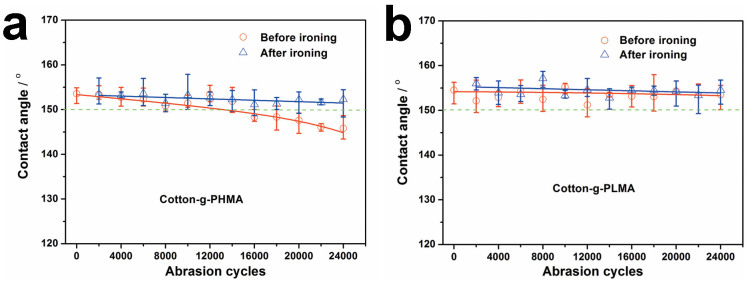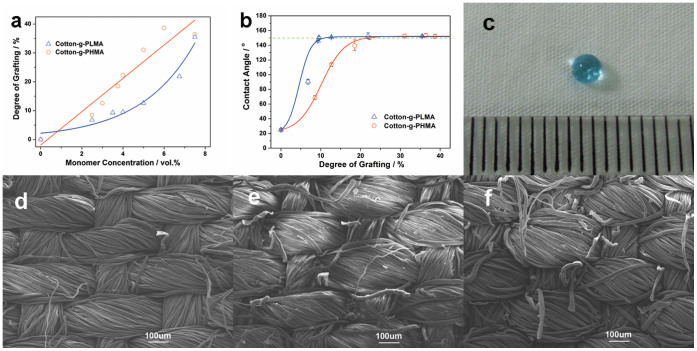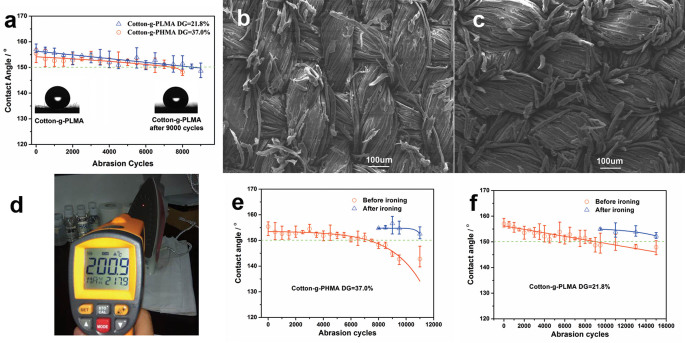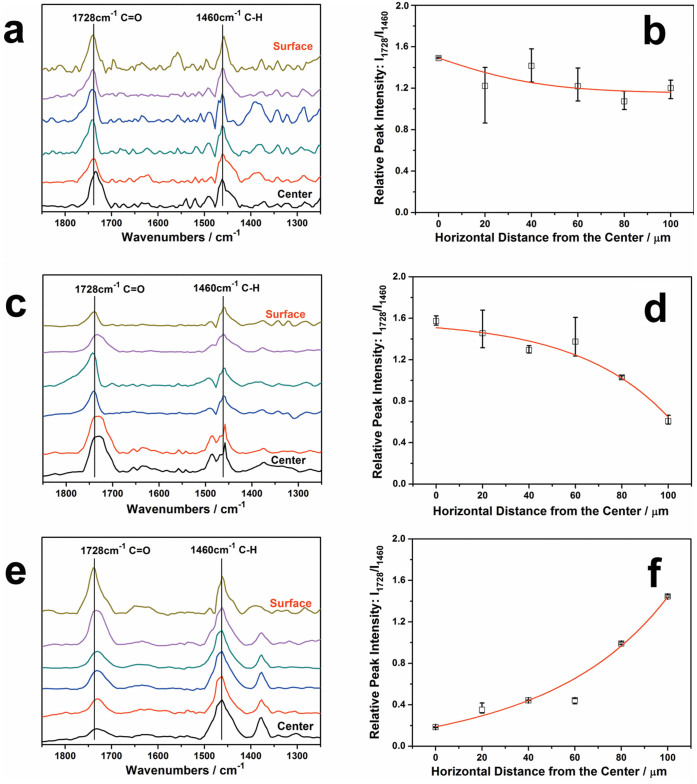Abstract
Self-healing of the superhydrophobic cotton fabric (SCF) obtained by the radiation-induced graft polymerization of lauryl methacrylate (LMA) and n-hexyl methacrylate (HMA), can be achieved by ironing. Through the steam ironing process, the superhydrophobicity of the SCFs will be regenerated even after the yarns are ruptured during the abrasion test under a load pressure of 44.8 kPa. SCFs made from LMA grafted cotton fabric can ultimately withstand at least 24,000 cycles of abrasion with periodic steam ironing. The FT-IR microscope results show that the migration of the polymethacrylates graft chains from the interior to the surface is responsible for the self-healing effect.
The superhydrophobic phenomenon, where a surface shows a contact angle (CA) of water greater than 150°, is an amazing occurrence in nature1,2,3 which can be found on the leaves of plants4,5, the legs of water strider6, etc. After decades of study, it has been reported that micro- and nano-scaled hierarchical structures and low surface energy are the two key parameters for superhydrophobic surfaces7,8,9,10. Superhydrophobic fabrics that are waterproof, and retain breathability have the potential use in our daily life11,12. Many researchers have reported on the preparation of superhydrophobic fabrics by means of finishing with low surface energy nano-particles13,14,15,16,17. From the practical viewpoint, the inability to sustain superhydrophobicity through multiple washings and abrasions is still a limitation in application.
To improve the mechanical stability of these surface-coated layers, the formation of covalent bonds between low surface energy nano-particles and the fabric is considered an important method and has resulted in good improvement18,19. The formation of low surface energy polymer film embedded with nano-particles on the fabric has also been reported as a method to prepare superhydrophobic fabrics with good abrasion resistance20. We have reported an alternative method21,22 to form these covalent bonds between cotton fabrics and the fluorinated polyacrylate by a radiation-induced graft polymerization technique where the superhydrophobic cotton fabric can remain its properties after 50 accelerated laundering cycles.
Recently, the durability of the superhydrophobic surfaces under chemical attack or mechanical abrasion became an important technical concern in their daily applications23,24,25,26. Zhou et al.23 reported that their superhydrophobic polyester fabric coated with fluorinated alkyl silane functionalised silica nanoparticles and polydimethylsiloxane can survive for 28,000 cycles of abrasion with a load pressure of 12 kPa, and result with no breakage to the fibers. Separately, a self-healing strategy where the superhydrophobicity can be regenerated after an oxidative plasma attack or chemical attack was reported24. The self-healing method takes advantage of the migration of those low surface energy molecules embedded under the surfaces to the damaged surface.
Here we report a not only abrasion durable but also self-healable superhydrophobic cotton fabric prepared by means of a radiation-induced graft polymerization technique. The superhydrophobicity of the products can survive after thousands of abrasions. More importantly, even after the mechanical damage, the superhydrophobicity can be regenerated by simply steam ironing. The affect can be attributed to the migration of the polymethacrylates graft chains from the bulk phase onto the surfaces due to the improved mobility under the raised temperature created by steam ironing. The heat from the steam ironing takes advantage of the graft polymerization happened not only on the surface but also within the bulk of the yarns of the fabrics.
Results
In this work, alkyl methacrylates with various linear alkyl chain lengths, CH2 = C(CH3)COO-(CH2)x-H, were used as the low surface energy functional monomers, and consisted of lauryl methacrylate (LMA, x = 12) and n-hexyl methacrylate (HMA, x = 6). To prepare the grafted cotton fabric, the cotton fabric samples were soaked in a monomer solution in methanol, and then irradiated by γ-ray in a 60Co facility to 30 kGy under the protection of N2 gas. After the graft polymerization, the homopolymers were thoroughly removed by means of hot solvent extraction for 72 hours. The degree of grafting (DG) was determined by calculating the weight increase percentage versus the original weight (details of the preparation are presented in the supporting information section). The kinetic curves of graft polymerization are presented in Figure 1a where the DG of the modified cotton fabric was controlled by adjusting the monomer concentration. Due to the similarity in the chemical structure of the monomers, the curves have the same trends that the DG increases quickly with the increased monomer concentration. Success in the graft polymerization was also proven via the FT-IR spectra of the grafted cotton fabrics (Supporting information, Figure S1 and S2) where there is an absorbent band around 1729 cm−1 attributed to the ester groups on the polymethacrylate graft chains as compared with the pristine cotton fabric27.
Figure 1.
a) The kinetic curves of the radiation induced graft polymerization of the alkyl methacrylate onto the cotton fabrics which present the dependence of the DG on the concentration of the monomers in methanol; b) The dependence of the CA on the DG of those cotton fabrics which are graft polymerized with LMA and HMA; c) The digital image of water droplet sit on the LMA grafted cotton fabric (Cotton-g-PLMA) with DG of 21.8%; d) SEM image of the pristine cotton fabric; e) SEM image of the LMA grafted cotton fabric (Cotton-g-PLMA) with DG of 21.8%; f) SEM image of the HMA grafted cotton fabric (Cotton-g-PHMA) with DG of 37.0%.
The pristine cotton fabric is hydrophilic, where the CA is about 25° (Supporting Information, Figure S3). After the graft polymerization, the fabrics become less hydrophilic. The CAs of the grafted cotton fabrics depend strongly on the DG, and also depend on the chain length of the alkyl groups of the methacrylate monomers, which are presented in Figure 1b. The curves indicate that the CA of the grafted cotton fabric quickly increases with growing DG as reported in our previous work21, and finally exceeds 150° after the DG is greater than a certain value. It will be identified as the required DG in order to achieve superhydrophobicity. For Cotton-g-PLMA, the required DG for superhydrophobicity is less than 10%, but it is about 20% for Cotton-g-PHMA. The lower DG required for the superhydrophobicity means not only lower costs, but also as little damage as possible to the pristine cotton fabric (Figure 1c).
The SEM images (Figure 1d, 1e and 1f) demonstrate that the radiation-induced graft polymerization technique does minimize the damage to the cotton fabrics, where the woven structure is retained for the LMA and HMA grafted cotton fabrics with the weight increment, i.e. DG, up to almost 40%. Additionally, the yarns become larger due to the graft polymerization. Furthermore, the SCF of the LMA and HMA grafted cotton fabrics have almost the same softness and smoothness as the pristine cotton fabric.
We then tested the mechanical stability for the SCF of LMA and HMA grafted cotton fabric using a crockmeter (Supporting information, Figure S4) according to GB/T 3920-2008 (equivalent to ISO 105-X12:2001, MOD), which presents a to-and-fro movement under pressure. The loading pressure of our crockmeter was 44.8 kPa. From the curves of the CA versus abrasion cycles in Figure 2a, the CA slightly decreased with the aggravated abrasion and the CA of Cotton-g-PHMA became less than 150° after 8,000 cycles, while Cotton-g-PLMA survives until 9,000 cycles. Zhou et al.23 reported that their superhydrophobic polyester fabric can survive for 28,000 cycles of abrasion with a load of 12 kPa, and the fibers and the surface coating layer were unchanged after the abrasion. In contrast, the abrasion applied in our case is at a four-fold higher magnitude and as a result many of the yarns are rubbed off during the test. SEM images of the SCF after abrasion test (Figures 2b and 2c) showed a similar scene where many yarns have been rubbed off.
Figure 2.
a) CA value versus the abrasion cycles of the Cotton-g-PHMA (DG = 37.0%) and the Cotton-g-PLMA (DG = 21.8%); Inserted images: the image of a water droplet on the Cotton-g-PLMA (DG = 21.8%) before (left) and after (right) an abrasion test of 9,000 cycles; b) SEM image of the Cotton-g-PHMA (DG = 37.0%) after an abrasion test of 8,000 cycles; c) SEM image of the Cotton-g-PLMA (DG = 21.8%) after an abrasion test of 9,000 cycles; d) The temperature measuring of the iron. e) CA value before and after the steam ironing versus the abrasion cycles of the Cotton-g-PHMA (DG = 37.0%); f) CA value before and after the steam ironing versus the abrasion cycles of the Cotton-g-PLMA (DG = 21.8%).
We noticed that after the test, the CA are less than 150°, but much greater than the value for pristine cotton fabric. This result further proves that the graft polymerization happens also in the bulk phase of the fabric, since the cotton fabric was soaked in the monomer solution and then irradiated. This mechanism means that the graft chains existing in the bulk phase can be used to restore the surperhydrophobicity of the material through migration of the grafted low surface energy polymer chains back to the surface of the fabric. Since ironing can eliminate wrinkles on the cotton fabrics (Figure 2d), it is a simple and feasible approach to execute the self-healing procedure of the damaged superhydrophobic fabrics. During the ironing, the temperature is higher than the relaxing temperature of cellulose macromolecules and the glass transition temperature (Tg) of the polymethacrylates which is less than 100°C (Supporting information, Figure S5)27.
After around 8,000 and 9,000 abrasion cycles for PHMA and PLMA grafted cotton fabrics, respectively, both modified cotton fabrics lost their superhydrophobicities (CA lower than 150°), as shown in Figure 2e and 2f. If these samples after the abrasion test were steam ironed with the recommended ironing temperature for cotton fabric at around 200°C, the CA of the worn fabrics after a certain cycles of abrasion regained their superhydrophobicity (Figure 2e and 2f). This abrasion-healing cycle was repeated for four or five times on PHMA and PLMA grafted cotton fabrics respectively and showed the SCFs can self-heal by retaining their superhydrophobicity through steam ironing.
To clarify the mechanism of the self-healing procedure of the superhydrophobic fabrics, the microscopic FT-IR spectroscopy study of the cross-section of a fixed yarn of the Cotton-g-PHMA was performed. The strong absorbent band around 1728 cm−1 attributed to the ester groups in the polymethacrylate graft chains can be found in the spectra (Figure 3a). The spectra are taken at a step-wise 20 μm scanning from the center to the surface of the yarn of the Cotton-g-PHMA. To tell the distribution of the graft chains in the yarn, the peak intensity ratio of the ester groups at 1728 cm−1 to the methylene of the cellulose macromolecules at 1460 cm−1 are presented in Figure 3b. The grafted polymethacrylate chains are distributed quite evenly within the SCF, only slightly higher level of grafting in the center. The distribution of the graft chains is disrupted after the abrasion test, where the ratio of the graft chains is almost constant in the center but decreased obviously while approaching to the surface (Figure 3c and 3d). This further shows those graft chains at the surface layer are heavily rubbed off during the abrasion test, and the interior less damage where the graft chains are well reserved. After the steam ironing, most of the graft chains at the center migrated back to the surface of the yarn and the ratio of the ester groups of the graft chains to the methylene of the cellulose macromolecules on the surface layer is restored to almost the same value as SCF put under no abrasion (Figure 3e and 3f). This procedure relieves the mechanism for the steam ironing induced self-healing behaviour of the SCF prepared by means of radiation-induced graft polymerization technique. Similar to the strategy to design the self-healing surface with the superhydrophobic coatings using a covalently attached fluoroalkylsilane layer24, the migration of hydrophobic PHMA and PLMA graft chains underneath the damaged fabric surface to the outer fabric surface minimized the interface free energy and is the key point for our strategy. Therefore, the SCFs are possessed with excellent self-healing property to retain their superhydrophobicity after abrasion.
Figure 3.
a) Microscopic FT-IR spectra of the cross-section of a single yarn of the Cotton-g-PHMA with the testing step of 20 μm from the center; b) The relationship between the peaks' intensity of the ether group and the methylene group and the distance from the center in the yarn; c) Microscopic FT-IR spectra of the cross-section of a single yarn of the Cotton-g-PHMA after the abrasion test; d) The relationship between the peaks' intensity of the ether group and the methylene group and the distance from the center in the yarn; e) Microscopic FT-IR spectra of the cross-section of a single yarn of the Cotton-g-PHMA after abrasion test and then steam ironing; f) The relationship between the peaks' intensity of the ether group and the methylene group and the distance from the center of the yarn.
Considering that people will periodically iron new clothes rather than the damaged ones, we conducted a test with the abrasion and periodic steam ironing on freshly prepared SCFs to see if the ironing can protect the superhydrophobicity. After every two thousand abrasion cycles followed by one steam ironing, we measured and compared the difference of CAs before and after ironing. The results showed that the lifetime of the superhydrophobic cotton fabric was obviously elongated by ironing. The CA of cotton-g-PHMA (Figure 4a) eventually drops below than 150° after 16,000 abrasion cycles and the CA drop almost doubled when no ironing was performed. However, once steam ironing was performed on the Cotton-g-PHMA, the superhydrophobicity of the cotton fabric was retained. For Cotton-g-PLMA (Figure 4b), the test lasted for 24,000 cycles and the CA remained higher than 150°, with or without ironing. This suggests that the SCF prepared by radiation-induced graft polymerization can be both self-healed and be also protected by ironing. This can be attributed to the grafted polymethacrylate chains in the bulk phase that can be migrated onto the surface under steam heating. When we tried to determine how many cycles of abrasions the Cotton-g-PLMA can withstand and still retain its superhydrophobicity, an accident occurred and the sample was torn. However, we know that the SCF made from LMA grafted cotton fabric can survive at least 24,000 cycles of abrasion under a load of 44.8 kPa with the “self-healing” treatment via periodic steam ironing.
Figure 4.

a) CA value before and after the steam ironing for every 2,000 abrasion cycles versus the abrasion cycles of the Cotton-g-PHMA; b) CA value before and after the steam ironing for every 2,000 abrasion cycles versus the abrasion cycles of the Cotton-g-PLMA.
Discussion
The durability of the superhydrophobic fabrics is an important parameter for the real applications. And we make effort to improving the durability of the SCF by means of a radiation-induced graft polymerization technique, where the high energy γ-ray can break the covalent bonds within the cellulose macromolecules randomly and induce the formation of new covalent bonds between the cellulose macromolecules with the grafted polymer chains. Here, the SCFs were obtained by grafting lauryl methacrylate and n-hexyl methacrylate onto cotton fabric by simultaneous radiation. The required DG is dependent on the alkyl-chain length of the functional monomers, where the longer the alkyl-chain length, the lower the DG needed for the superhydrophobicity. The woven structure was well preserved and the products feel as smooth as the pristine cotton fabric. The superhydrophobicity can be retained for thousands of cycles of abrasion at a load of 44.8 kPa. Furthermore, the self-healing effect can be achieved by applying a steam ironing treatment to affect the migration of the graft chains from the bulk phase onto the surface layer. The SCF made from LMA-grafted cotton fabric has excellent self-healing effect as it can survive for at least 24,000 cycles of abrasion with periodic steam ironing, even though the fabric itself is torn. Additionally, the mechanism of the self-healing is due to the distribution of the graft chains in the bulk phase during the radiation-induced graft polymerization procedure, which means the technology is a good approach to prepare the self-healing superhydrophobic materials, not limited to the fabrics.
Methods
CA measurement
CA was measured on an Attension Theta system (KSV Instruments Ltd., Finland), with a volume of 5 μL deionized water. Static contact angles were determined from these images recorded by a digital camera with the supplied calculation software. Every sample was measured at 5 different points and the contact angle was the average of these data.
Abrasion test
The mechanical durability of the SCF was evaluated by a dry crocking method according to the GB/T 3920-2008 (equivalent to ISO 105-X12:2001, MOD) standard. The samples were fixed on an automatic crockmeter (571-III, Wenzhou Darong Textile Instrument Co., Ltd). The loading force was 9 N and the diameter of the cooper head was 16 mm, therefore the loading pressure was 44.8 kPa. The movement rate of the copper head was 0.3 m/s.
Ironing test
FT-9201 Steam Iron (Shanghai Flyco Electrical Appliance Co., LTD) are used according to the QB/T 2926-2007 (equivalent to AATCC133-2004) standard. The ironing time is 5 min.
Author Contributions
J.L. designed and supervised the project. J.W., H.J. and Z.W. performed the material preparation. J.W., M.Y., L.L., C.X. and Y.L. conducted the characterization. J.W., J.L. and B.D. analysed the data and wrote the manuscript. All authors reviewed the manuscript.
Supplementary Material
Supporting information for publication
Acknowledgments
We thank Mr. Lai Benjamin for the help in language polishing. This work was supported by National Natural Science Foundation of China (11175234, 11105210), the “Strategic Priority Research Program” of the Chinese Academy of Sciences (XDA02040300), the “Knowledge Innovation Program” of the Chinese Academy of Sciences (KJCX2-YW-N49), and Shanghai Municipal Commission for Science and Technology (11ZR1445400 and 12ZR1453300).
References
- Feng L. et al. Super-hydrophobicity of nanostructured carbon films in all pH range. Angew. Chem. Int. Ed. 115, 4349–4352 (2003). [Google Scholar]
- Crick C. R. & Parkin I. P. Preparation and characterisation of super-hydrophobic surfaces. Chem. Eur. J. 16, 3568–3588 (2010). [DOI] [PubMed] [Google Scholar]
- Verho T. et al. Mechanically durable superhydrophobic surfaces. Adv. Mater. 23, 673–678 (2011). [DOI] [PubMed] [Google Scholar]
- Feng L. et al. Super-hydrophobic surfaces: from natural to artificial. Adv. Mater. 14, 1857–1860 (2002). [Google Scholar]
- Barthlott W. et al. The salvinia paradox: Superhydrophobic surfaces with hydrophilic pins for air retention under water. Adv. Mater. 22, 2325–2328 (2010). [DOI] [PubMed] [Google Scholar]
- Gao X. F. & Jiang L. Biophysics: Water-repellent legs of water striders. Nature. 432, 36 (2004). [DOI] [PubMed] [Google Scholar]
- Abbott N. L., Folkers J. P. & Whitesides G. M. Past studies of the patterning of aqueous solutions on surfaces have relied on the fabrication of surfaces that have hydrophilic and hydrophobic regions. Science 257, 1380–1382 (1992).17738280 [Google Scholar]
- Gau H., Herminghaus S., Lenz P. & Lipowsky R. Electrochemical principles for active control of liquids on submillimeter scales. Science 283, 46–49 (1999). [DOI] [PubMed] [Google Scholar]
- Jiang L., Zhao Y. & Zhai J. A lotus-leaf-like superhydrophobic surface: A porous microsphere/nanofiber composite film prepared by electrohydrodynamics. Angew. Chem. Int. Ed. 43, 4338–4341 (2004). [DOI] [PubMed] [Google Scholar]
- Luo C. et al. Flexible carbon nanotube−polymer composite films with high conductivity and superhydrophobicity made by solution process. Nano Lett. 8, 4454–4458 (2008). [DOI] [PubMed] [Google Scholar]
- Tuteja A. et al. Designing superoleophobic surfaces. Science 318, 1618–1622 (2007). [DOI] [PubMed] [Google Scholar]
- Shang C. J. (Ed.) Functional Textiles, (China Textile & Apparel Press, Beijing, China, 2006). [Google Scholar]
- Tuteja A., Choi W., Mabry J. M., McKinley G. H. & Cohen R. E. Robust omniphobic surfaces. Proc. Natl. Acad. Sci. 105, 18200–18205 (2008). [DOI] [PMC free article] [PubMed] [Google Scholar]
- Choi W. et al. Fabrics with tunable oleophobicity. Adv. Mater. 21, 2190–2195 (2009). [Google Scholar]
- Ramaratnam K., Tsyalkovsky V., Klep V. & Luzinov I. Ultrahydrophobic textile surface via decorating fibers with monolayer of reactive nanoparticles and non-fluorinated polymer. Chem. Comm. 4510–4512 (2007). [DOI] [PubMed] [Google Scholar]
- Wang H. X. et al. One-step coating of fluoro-containing silica nanoparticles for universal generation of surface superhydrophobicity. Chem. Comm. 877–879 (2008). [DOI] [PubMed] [Google Scholar]
- Wang H. X. et al. Durable, self-healing superhydrophobic and superoleophobic surfaces from fluorinated-decyl polyhedral oligomeric silsesquioxane and hydrolyzed fluorinated alkyl silane. Angew. Chem. Int. Ed. 50, 11433–11436 (2011). [DOI] [PubMed] [Google Scholar]
- Gao Q. W., Zhu Q., Guo Y. L. & Yang C. Q. Formation of highly hydrophobic surfaces on cotton and polyester fabrics using silica sol nanoparticles and nonfluorinated alkylsilane. Ind. Eng. Chem. Res. 48, 9797–9803 (2009). [Google Scholar]
- Su C. H. & Li J. The friction property of super-hydrophobic cotton textiles. Appl. Surf. Sci. 256, 4220–4225 (2010). [Google Scholar]
- Zimmermann J., Reifler F. A., Fortunato G., Gerhardt L.-C. & Seeger S. A simple, one-step approach to durable and robust superhydrophobic textiles. Adv. Funct. Mater. 18, 3662–3669 (2008). [Google Scholar]
- Deng B. et al. Laundering durability of superhydrophobic cotton fabric. Adv. Mater. 22, 5473–5477 (2010). [DOI] [PubMed] [Google Scholar]
- Cai R. et al. Radiation induced graft polymerization of a fluorinated acrylate onto fabric. Radiat. Phys. Chem. 81, 1354–1356 (2012). [Google Scholar]
- Zhou H. et al. Fluoroalkyl silane modified silicone rubber/nanoparticle composite: A super durable, robust superhydrophobic fabric coating. Adv. Mater. 24, 2409–2412 (2012). [DOI] [PubMed] [Google Scholar]
- Li Y., Li L. & Sun J. Bioinspired self-healing superhydrophobic coatings. Angew. Chem. Int. Ed. 49, 6129–6133 (2010). [DOI] [PubMed] [Google Scholar]
- Wang X., Liu X., Zhou F. & Liu W. Self-healing superamphiphobicity. Chem. Commun. 47, 2324–2326 (2011). [DOI] [PubMed] [Google Scholar]
- Wang H. X. et al. Durable, self-healing superhydrophobic and superoleophobic surfaces from fluorinated-decyl polyhedral oligomeric silsesquioxane and hydrolyzed fluorinated alkyl silane. Angew. Chem. Int. Ed. 50, 11433–11436 (2011). [DOI] [PubMed] [Google Scholar]
- Brandrup J., Immergut E. H. & Grulke E. A. (Ed.) Polymer Handbook, 4th ed., (J. Wiley and Sons, New York, 2003). [Google Scholar]
Associated Data
This section collects any data citations, data availability statements, or supplementary materials included in this article.
Supplementary Materials
Supporting information for publication





